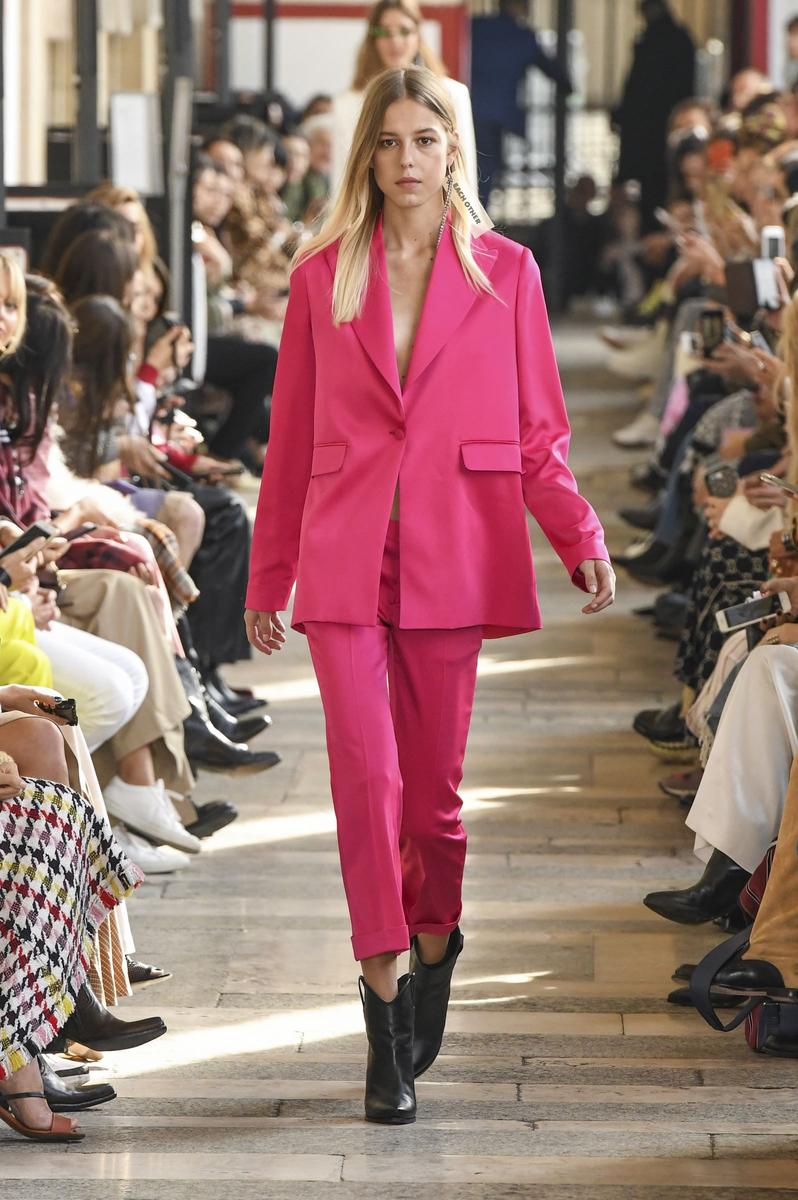Tailoring for ladies: the suit is making a strong comeback this season<
Appearing right in the middle of the Off-White Spring/Summer 2019 show, a flave set, in this particular pale yellow shade verging on green, slipped between the passage of vaporous white pants and that of a black dress. Bodycon stretch. Consisting of a long jacket enhanced with a flat silver banana and half-cropped, half-cycling bottoms, this outfit crystallizes the transformation of a classic, the suit, which has left the stilted sphere to take to the streets .
Related8 Ideas for Playing Style Heroines in Colorful CostumesIn Prince of Wales check, checkered, striped, houndstooth, plain in colorful colors, pink, red, green, even yellow, the trouser suit is everywhere. From catwalks to mass market brands, to young designers, to mid-range brands. Finished the simple blazer-trousers in rigid gray or black cotton, office uniform style. "We now wear it as a total look, we assume it," says Claire Remy, head of style at the Carlin International consulting firm. , falling almost into the caricature of the sexy secretary with very marked shoulders."
"The tuxedo, the very symbol of male power"
Influenced by the tidal wave of streetwear, the tailor has freed himself from a side that is a little kitsch or too pompous. It mixes a sporty and feminine aspect. It is often adjusted, sometimes even made in semi-measurement, including at accessible brands. "I wanted to make the product a little less old-fashioned and formal. I like the idea that you can wear it day and night, that it's no longer just a work outfit", confirms designer Diane Ducasse , which renews the costume with its Da/Da label.
It's been a century since the tailor was adopted by women. Amantine Aurore Lucile Dupin, better known as George Sand, already wore it in the 19th century to make herself up as a man. She was an exception then. The author Colette or the actress Marlene Dietrich then took up the torch, this time openly claiming gender equality, by wearing boyish suits from the 1920s. "The wearing of trousers was then prohibited for women , who had only been entitled, since the Belle Epoque, to panties for riding a bicycle. This law was only officially repealed in 2013!", says fashion historian Catherine Örmen, author of Un century of fashion (Larousse).
Yves Saint Laurent and the women's tuxedo

It was not until 1967 that a couturier, Yves Saint Laurent, created a suit specially intended for women. "The previous year, he introduced the tuxedo, the very symbol of male power, which exudes standing, an allure. It becomes the elegant uniform of women, adds the historian. Saint Laurent first launched it in haute couture, but the customers found it absurd. It was by presenting it in ready-to-wear that it had the success that we know of. The legalization of the contraceptive pill in 1967, then that of abortion in 1975, led to a period of sexual liberation during which it moved into women's wardrobes. The fashion is then to play genres. Wearing a suit shows a form of freedom from diktats.
"Women adopt the closed garment, which was th century, while that of the woman was always open", specifies Catherine Örmen. Diane Keaton then immortalized, with unprecedented class, the boyish look in the film Annie Hall, by Woody Allen, in 1977. Then came the 80s and the famous working girl look, with jackets with imposing shoulder pads and trousers often replaced by a miniskirt. The minimalism of the 90's is then essential, the suit, always black, gray or blue is then sober, slim and simple. It gradually disappeared in the 2000s to begin a comeback from 2012, corresponding to the tomboy look advocated by Lanvin, Dior or Dries Van Noten. It has been making a strong comeback for the past few seasons, especially on the red carpets, where it is increasingly replacing princess ball-style cocktail dresses.
"It gives self-confidence, it brings nonchalance"
At a time when the boundaries between styles, genders, professional and personal life are crumbling, the costume is asserting itself as an outfit that suits everyone, for any occasion. A sort of chameleon ensemble that crosses time, while adapting to it. Which is kept, even transmitted. It is no longer just a holdover from the men's locker room. He kept the aura of power he gave off in men to be, in women, associated with a form of empowerment. "It gives self-confidence, it brings nonchalance. When I put one on, I don't ask myself questions, unlike a dress, which can raise questions, Is it too sexy? Is it too showy A beautiful woman doesn't always need to show her sex appeal as a matter of course," explains Claire Thomson-Jonville, stylist and artistic director, who has been collaborating with Pallas for three seasons.
For the first time, in response to demand, she also designed models for men. “I am inspired by men and men love my women's fashion!” she laughs. This desexualization of clothing fits perfectly with a millennial generation that appreciates less formal things and does not hesitate to associate big sneakers and tuxedos. Or wear the suit with a simple lace bra under the jacket. "There is a paradox, because it thwarts identities but has never been so codified!, is surprised Claire Remy, of Carlin International. The bottom must be fitted, the jacket is buttoned on the right and not on the left, we have the right to tuck the jacket into the pants, etc. He continues to impose rules." Rejuvenated, democratized, the costume does not depart from its elegant rigor.
-------------------------
Read also :
8 ideas for playing style heroines in colorful costumes
Three ways to wear the costume according to the Cannes jury
Aigle, Adidas, American Vintage... beige + flowers, the fashion equation of the week


 Tags:
Tags: Prev
Prev







